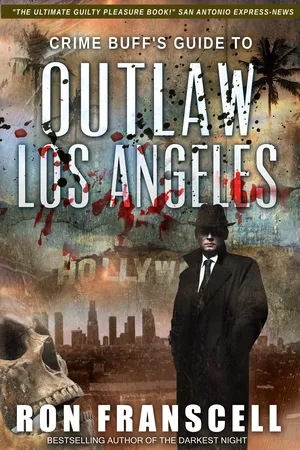![]()
II
LOS ANGELES
PRELUDE TO A RIOT
Bell
The crime scene known as the Sleepy Lagoon is believed to have been at the dead-end of Lindbergh Lane, or GPS 33.995869, -118.172977.
In 1942, it was nothing more than a farm reservoir, but to the Mexican-American teens who used it as a lover’s lane and a popular swimming hole, it was known as Sleepy Lagoon, after a popular Harry James song. It was a happy getaway for a bunch of kids who usually didn’t have the money or the access to the same kind of fun known to the kids in the Anglo part of the city.
The fun ended on one hot summer night in 1942.
On August 1, several couples from the nearby barrio on 38th Street drove to Sleepy Lagoon for some romance. While they necked in their cars, a group of boys from another neighborhood jumped them. Henry Leyvas and his girlfriend Dora Barrios were badly beaten.
Leyvas went home to his 38th Street neighborhood and roused a couple dozen friends for revenge. They returned to Sleepy Lagoon but found no gangs waiting for them. Instead, they descended upon a nearby ranch where a birthday party was in full swing. An all-out rumble ensued.
While cleaning up the mess the next morning, friends found the body of José Diaz, mortally stabbed and beaten to a pulp. Diaz was a good kid who was about to report to Army boot camp, but instead, he died that night.
Angered by gang violence, LAPD rounded up hundreds of “zoot-suiters”—mostly Chicano boys who dressed up in wide-shouldered, long coats, balloon pants, and flamboyant hats. A grand jury indicted Leyvas and 16 friends for killing Diaz.
Their trial was front-page news for months. The city was uncomfortable with tales of increasingly violent Hispanic youths, especially as a war raged. Local papers railed against zoot-suiters in general, and against Leyvas’ 38th Street boys in particular.
A jury convicted Leyvas of murder and sent him to San Quentin for life.
Latino blood boiled, and as the temperature rose in the barrios, it also rose in Anglo neighborhoods and military barracks all over California. Tension was high.
By the summer of 1943, it bubbled over. In several cities, including Los Angeles, groups of zoot-suiters were attacked and stripped of their clothes by white gangs and groups of servicemen. The zoot suit had been equated with thuggery.
The barrios began fortifying themselves for the attacks, contriving traps for anyone with evil intentions who came near.
For more than a week, Los Angeles’ so-called “Zoot-Suit Riots” continued without any interference by cops. When it finally ended, it was miraculous that nobody was killed, but police arrested far more Hispanics than Anglos, and a new era of civil-rights policy changes had begun.
Leyvas and his cohorts were released from prison after only one year. Zoot suits fell out of style. Sleepy Lagoon was filled in as postwar urban sprawl pushed out from the city center.
Enrique “Henry” Leyvas (1923-1971) later joined the Merchant Marine during World War II, but after the war, he went to prison for 10 years on a drug-dealing charge. When he got out, he opened a restaurant called Hank’s on Whittier Boulevard. He never married, and died of a heart attack at age 48.
Nobody ever paid the price for killing Jose Diaz (1919-1942), who is buried in Los Angeles’ Calvary Cemetery. His grave is in Section N, Lot 455, Grave 6.
THE PARENT TRAP
Beverly Hills
The crime scene is at 722 North Elm Drive, or GPS 34.084546, -118.402737. This is a private residence.
Jose Menendez lived the American dream. In 1960, at 15, he was sent by his Cuban parents to America. Subsequently, he attended college, married a beautiful woman, and began a series of increasingly high-paying and powerful corporate executive positions at such companies as Hertz and the record division of RCA. In 1986, he took a new job as CEO in the video division of Hollywood heavyweight Carolco Pictures. José was tough and had a good head for business. He could play hardball with some of the most cutthroat players in town.
His family grew, and they soon moved into a luxurious, six-bedroom house on Beverly Hills’ swanky Elm Drive, where he and his wife Kitty raised their sons Lyle and Erik in the good life. In time, Lyle went off to Princeton (where he was suspended for plagiarism) and Erik attended the Gucci-est high school in America, Beverly Hills High.
On the night of August 20, 1989, near the end of summer vacation, Lyle was 21 and Erik 18 when they came home from the movies to find their parents, or at least the pulpy mess that was left of them, shot to death in their home’s TV room. Fourteen 12-gauge shotgun blasts had rendered them all but unrecognizable as humans.
Police first suspected a mob hit, but one by one, their leads came up empty.
As the investigation continued, José and Kitty Menéndez were buried together in the Princeton Cemetery in Princeton, New Jersey.
Six months after the shooting, having already begun to lavishly spend their parents’ money, the brothers were arrested. Erik had hired his former tennis coach as a personal trainer, paying him a salary of $60,000 per year. They had both hired personal bodyguards, asserti...
